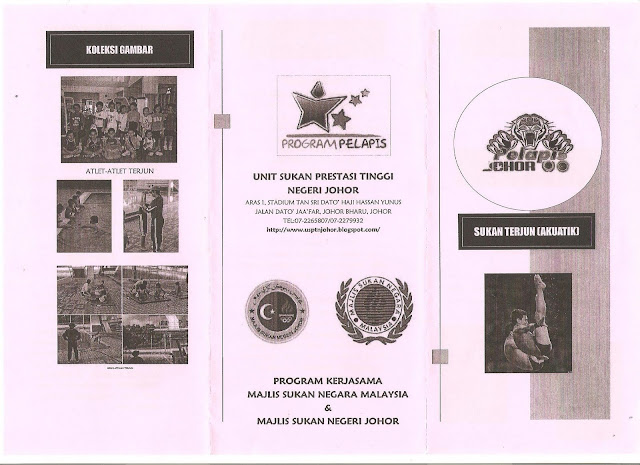Thursday, April 15, 2010
FASA 1/2010
14 & 15 APRIL 2010
TEMPAT : SEKOLAH-SEKOLAH TERLIBAT




Tuesday, April 13, 2010
TARIKH : 14-15 APRIL 2010
SEKOLAH-SEKOLAH TERLIBAT:
- SK Tanjung Puteri
- SJKC FOON YEW 1
- SJKC FOON YEW 2
- SJKC FOON YEW 3
- SK ANGKATAN TENTERA
- SK INFANT JESUS CONVENT
Pada 14 dan 15 April 2010 satu Program Mengenalpasti Bakat Sukan Terjun akan dijalankan di sekolah-skolah yang disebut diatas. Tujuan program ini diadakan adalah bagi mencari bakat-bakat baru untuk diserap ke dalam program Pelapis Johor dan akan dilatih dengan bimbingan Jurulatih yang berpengalaman dengan latihan yang bersistematik. Program tertumpu kepada pelajar di tahun 1 iaitu yang berumur 7 tahun sahaja kerana penglibatan bagi sukan terjun haruslah bermula dari awal persekolahan lagi agar fizikal pelajar mudah dilentur dan senang di bentuk kerana kelenturan badan seseorang pelajar amatlah penting bagi menjadi seorang penerjun yang baik. Pihak USPTN amat berterima kasih kepada Pihak Unit Sukan Jabatan Pelajaran dan Guru Besar di setiap Sekolah kerana telah membenarkan program ini dijalankan. Moga dengan usaha sama ini Negeri Johor akan mampu melahirkan atlet-atlet terjun terbaik dan setanding negeri-negeri lain.
Sekian.
Wednesday, March 31, 2010
DATE: 26-31 Mac 2010
VENUE:Pusat Akuatik Paroi Seremban
ORGANIZER: Cawangan Pelapis/ USPTN N.Sembilan
PARTICIPANT:55 divers from age 7-12, SDO-10, JPM-6, JLN-5
Sebuah lagi Kem Bakat Terjun telah diadakan untuk kali pertama bagi tahun 2010. Gabungan atlet dari Kumpulan A dan B dari setiap negeri telah memberi peluang bagi semua JPM,JLN dan JSM untuk berlatih bersama disamping dapat berkongsi pengalaman serta mempelajari sesuatu yang baru. Kem kali ini diselitkan juga dengan sesi Pembentangan dari Pegawai Pembangunan Negeri berkenaan Program Latihan Terjun. Pelbagai masalah, cadangan serta idea-idea baru dapat diperbincangkan semasa pembentangan tersebut, terutamanya cara untuk meningkatkan mutu prestasi atlet di setiap negeri. Pengarah dari Cawangan Pelapis juga amat menggalakkan penglibatan bekas-bekas atlet terjun untuk dijadikan jurulatih pada masa akan datang berikutan program ini amat ketandusan jurulatih yang berpengalaman dalam arena terjun ini.
Kelainan bagi kem kali ini dibandingkan kem yang sebelumnya adalah, kem kali ini telah ditambah dengan sesi Ujian Spesifik Terjun yang kali pertama telah dijalankan oleh pihak ISN disamping itu diisi lagi dengan Slot dari ISN (Institut Sukan Negara) akan kepentingan Pemakanan dan Psikologi dalam Sukan. Sesi sesi selainnya dipadatkan lagi dengan sesi latihan di Diving Pool dan Dryland. Jurulatih telah menggunakan masa yang ada sepenuhnya dengan menjalankan latihan memandangkan peralatan di Pusat Akuatik Paroi adalah lengkap.
Diharap Kem kali ini dapat dimanfaatkan oleh jurulatih dan atlet sepenuhnya kerana pada kem akan datang kumpulan yang besar ini akan dikecilkan lagi kepada kumpulan yang terbaik sahaja.
Akhir sekali diucapkan jutaan terima kasih kepada semua pihak yang terlibat semasa kem dijalankan terutama sekali urusetia tuan rumah USPTN Negeri Sembilan.
Sekian.
 DURING MINI COMPETITION
DURING MINI COMPETITION
 FITNEST TEST WITH ISN
FITNEST TEST WITH ISN DURING DRYLAND TRAINING
DURING DRYLAND TRAINING LEISURE TIME WITH KFC
LEISURE TIME WITH KFCTuesday, March 23, 2010
During the flight of a dive, the body must be held in one of four positions: tuck, pike, straight, or free. Each of these positions is designated by a letter on diving score sheet.
- Straight - A
- Pike - B
- Tuck - C
- Free - D
Straight Position
The straight position is characterized by no bend in either the hips or knees. The arm position is the choice of the diver.
Pike Position
The pike position is performed with the knees straight and the body bent at the waist. A proper pike position will demonstrate no gap between the upper body and the legs. Pike position can be performed with the hands touching the feet or extending out from the body in an open pike position, or with the arms wrapping around the legs in a closed pike position.
Tuck Position
Tuck Position

The tuck position resembles a ball with the knees bent and the legs pulled as close to the body as possible. Each hand should grasp the leg on the shin, midway between the knee and the ankle. The toes should be pointed and the legs kept together.
Free Position
Free Position

Diving Meet Requirements
Voluntary Dives
Although the term is a bit misleading as voluntary dives are not truly voluntary, for simplicity sake think of these dives as the easier or compulsory dives.
In the past voluntary dives were referred to as required dives and many coaches today still refer to these dives in an off-hand way as "requireds."
Voluntary dives demonstrate that a diver has mastered basic techniques in the approach and hurdle such as balance and coordination, aesthetic qualities such as physical presence, grace, and form, and the awe-inspiring entry into the water with little or no splash.
While many diving contests are won by completing the optional dives for high scores, divers can put themselves at a great disadvantage by not being able to perform voluntary dives for the same high scores.
The use of “Vols” has changed over the years, having been phased out of individual senior, elite and Division I NCAA competitons. They are currently still used in novice, junior and high school competitons where they are instrumental in the a diver’s development. On the elite level, voluntaries are still used in synchronized diving.
Depending on age and the type of contest (high school, USA Diving, etc.) in which voluntaries are used, divers are required to perform a set of dives that have a limit on the total degree of difficulty when added together. These dives must come from separate diving groups - forward, back, reverse, inward, twisting, and handstand (only used in platform diving), and can be chosen by the diver; but a diving group cannot be repeated.
For example, female divers in a USA Diving sanctioned 16-18 age-group contest on the one-meter springboard must perform five voluntary dives from each of the five diving groups and the total degree of difficulty cannot exceed 9.0.
Voluntary Dives
- Number and scope is determined by diver’s age and type of event
- Dives must come from a predetermined set number of diving groups
- Limits on the total degree of difficulty
Optional Dives
Optional dives in competitive diving are the harder and more impressive dives performed in a divers list of dives. They can range from a forward 1 ½ in the pike position on the one-meter springboard, to a reverse 3 ½ in the tuck position from the ten-meter platform.
When the optional dives are combined with the required voluntary dives, the result is a list of dives that a diver must perform in a particular diving meet or contest. This in commonly known as a “divers’ list.”
As with the requirements for the voluntary dives, depending on age and the type of event (high school, USA Diving, etc.), divers are required to perform a predetermined number of optional dives from different diving groups without limit on the total degree of difficulty (D.D.) of these dives.
A diver can put himself or herself at a great disadvantage by not being able to adequately perform voluntary dives but make no mistake about it – optional dives win diving contests!
One important thing to remember though, despite that fact that there are no limits on the degree of difficulty, a diver should avoid doing the hardest dives possible just because they have more D.D. and they can complete the dive. The object of any diving competition is to score more points than the opponent. And being able to do a dive with lower D.D. well, is more prudent than doing a higher D.D. dive for lower scores.
Example: Forward 2 ½ Tuck vs. Forward Double Tuck
A diver may be able to complete a forward 2 ½ somersault in the tuck position with a D.D. of 2.4, but only receive a score of three from each of the diving judges. However, this diver may be able to consistently do a forward double tuck with a D.D. of 2.2, and receive a score of five from each of the judges.
In this case, when the judges scores and the D.D. are multiplied together, the forward double scores over 10 points more than the forward 2 ½. In a diving contest which can be decided by a tenth of a point, that 10-point difference can have an enormous impact. In addition, the confidence gained from doing a dive well is worth its weight in gold.
Depending on the age group and level, optional dives must come from two or more of the diving groups - forward, back, reverse, inward, twisting, and handstand (only used in platform diving), and can be chosen by the diver; but a diving group cannot be repeated.
For example, female divers in the 16-18 age group on the one-meter springboard are required to perform four optional dives, each from a different diving group.
Optional Dives
- Number and scope is determined by diver’s age and type of event
- Dives must come from a predetermined set number of diving groups
- No limit on the total degree of difficulty


















